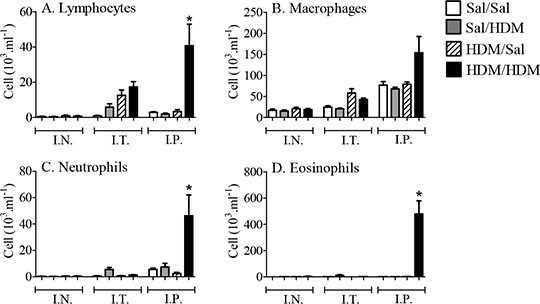121P Queen Elizabeth II Conference Centre London
BPS Winter Meeting 2012 |
Topical HDM Sensitisation: Does It Lead To A Model Of Allergic Asthma?
N Dale, K Raemdonck, MG Belvisi, MA Birrell. National Heart and Lung Institute, Imperial College London, London, UK
To model allergic asthma there has recently been a switch to using repeated topical challenges with House Dust Mite (HDM). Our group questioned whether this model is appropriate (Birrell et al. 2010). We have reported that a single topical challenge with HDM leads to airway inflammation in rats and mice (De Alba et al. 2010, Eltom et al, 2010); we feel it is difficult to delineate whether the endpoints routinely measured in these models (airway cellular inflammation and AHR) are a consequence of repeat innate responses to HDM or are associated with prior sensitisation/allergy. To circumvent these issues, we developed a model where mice are sensitised systemically with HDM (twice, i.p., without Alum) and then challenged with a dose of HDM that does not trigger airway inflammation or AHR in mice not previously exposed to the allergen (Dale et al., 2011).
The aim of this study was to use the protocol/timings developed for the systemic model to determine if delivering the HDM topically (either the low dose used in our systemic model, or high enough to induce innate airway inflammation), would sensitise the mice to respond to a subsequent HDM challenge.
Male C57Bl/6 mice (18-20 grams) were sensitised (day 0 and 14) with saline or HDM intraperitoneally (0.5 µg.kg-1 in saline, 100µl per mouse), intranasally (0.5µg.kg-1 in saline, 50µl per mouse), or intratracheally (1250 µg.kg-1 in saline, in 25µl). Mice were challenged on days 24-26 with saline or 1.25µg.kg-1 HDM intranasally. Approximately 72 hours after final challenge, airway responsiveness to inhaled saline or 5-HT (1-10mg.kg-1) was assessed (whole body plethysmography (WBP): Penh) and cellular inflammation was assessed in the BAL fluid.
HDM challenge resulted in a significant increase in the levels of BAL lymphocytes, eosinophils and neutrophils (Figure 1) in mice sensitised systemically (i.p.) compared to HDM sensitised/saline challenged mice (p<0.05 Mann-Whitney U-test). However neither topical sensitisation with “low dose (intranasal) HDM” nor “high dose (intratracheal) HDM” resulted in an increase in airway inflammatory cells after HDM challenge compared to the control groups.
In addition, allergic airway hyperresponsiveness to inhaled 5-HT was only observed after HDM challenge in mice which were sensitised systemically (i.p.). Penh area under the curve values for i.p, sensitised mice after 3mg.ml-1 5-HT were: saline/saline – 845.3 ± 55.42, Saline/HDM – 870.1± 77.21, HDM/saline – 767.8 ± 66.30, HDM/HDM 1521* ± 121.7 (*=p<0.05 Mann-Whitney U-test vs. HDM/saline controls).
In our hands, neither topical protocol was able to “sensitise” the mice so they responded to a HDM challenge, whereas systemic sensitisation resulted in robust airway cellular inflammation and airway hyperresponsiveness.


Figure 1: Comparison of sensitisation routes in the generation of allergic inflammation after HDM challenge.
Data expressed as mean cell number + SEM for n=6-8/group. *=p<0.05 vs relevant HDM sensitised/saline challenged controls, Mann-Whitney U-test.
De Alba, J., et al (2010) ERJ 35: 1377–1387.
Birrell, M. A., et al (2010) 36: 1220–1221
Eltom S, et al., 2010 AJRCCM.181: A2837.
Dale N, et al., (2011) Proceedings of B.J.P. 9:3:90P
|